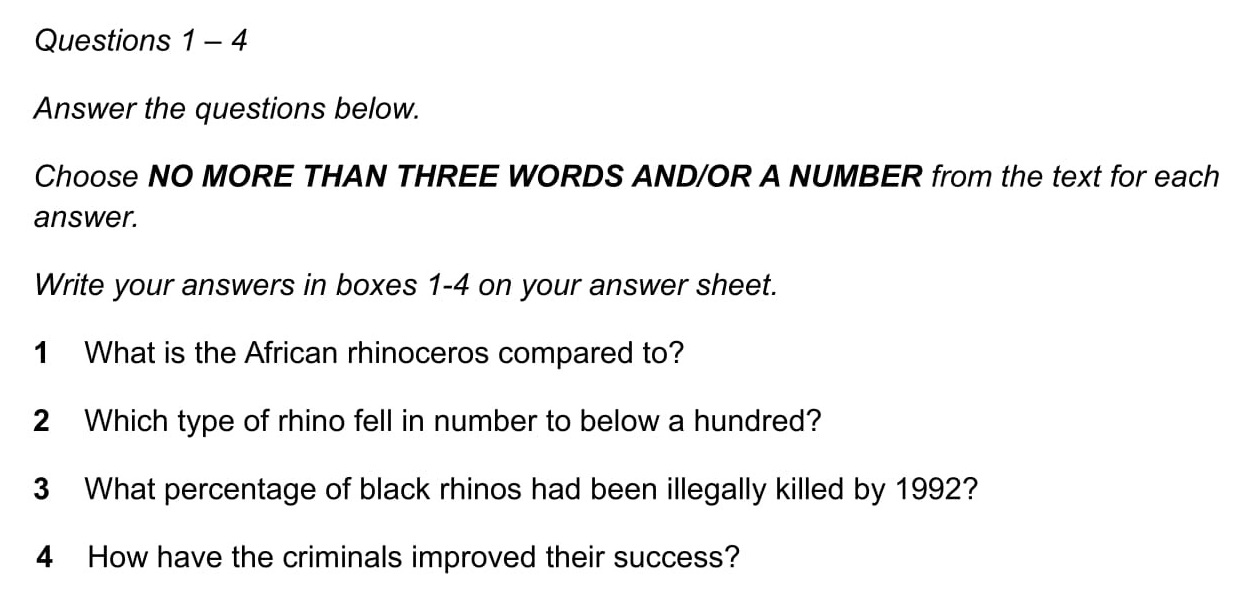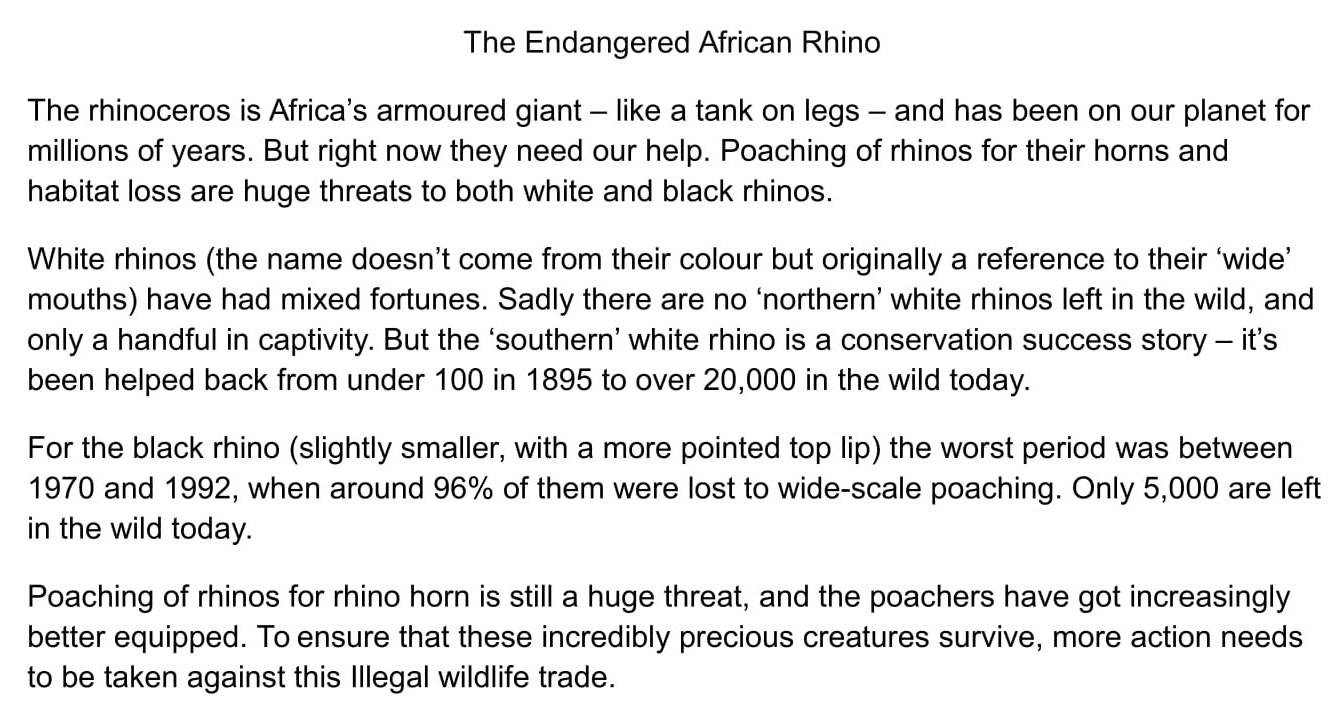IELTS Reading
Short Answer Questions
Many students find short answer questions amongst the easiest to answer. You have to read a text and answer a set of questions about it in one to three words.
Because this type of IELTS Reading question is generally not too difficult, it’s tempting to try to rush through the questions. This results in silly mistakes being made. Be careful not to lose valuable marks this way.
To help you get the best score possible, and avoid these mistakes, I’m going to cover the following
things on this page:
- Skills needed
- Key tips
- Strategy to use
- Example &
model answers
Skills needed
Short answer questions test your ability to:
- Quickly skim the text for the general meaning.
- Identify key words.
- Scan for specific information.
- Recognise synonyms and paraphrasing.
Key tips
1) Read the questions first, then
the text. It’s important that you understand what is being asked in the
questions before looking at the text. You will then know the main ideas to look
out for as you skim read.
2) The answers will be in order in the text. So, once you've found the answer to question 1, you’ll know that the answer to question 2 will come soon after, and so on.
3) Don’t go over the word limit stated for your answers, for example, ‘NO MORE THAN THREE WORDS AND/OR A NUMBER.’
If you do, your answer will be marked ‘wrong’ even if the information you give is correct.
4) Use only the actual words from the text for your answer. You may need to change the tense of any verbs you use to ensure your answer is grammatically correct.
5) Most questions will contain synonyms or paraphrasing of the text, that is, the meaning will be the same but the wording slightly different.
Strategy
Follow this strategy for answering short answer questions in your IELTS Reading test.
# 1 Reading
the instructions very carefully taking particular note of the word limit for
your answers.
# 2 Read the questions and try to understand what is being asked.
# 3 Underline key words in the questions. Also, think about possible synonyms for them.
Don’t worry if there are unfamiliar words. If they also appear in the text, you may be able to work them out in context. Alternatively, synonyms that you do understand may have been used.
# 4 Skim read the text. Be alert for the keywords and synonyms you identified but don’t read in detail.
Read the first sentence of each paragraph in a little more detail than the rest of the text as this will introduce the main idea of the paragraph.
# 5 Go back and re-read question 1, then scan the first paragraph, maybe the second as well, until you find the location of the answer. Then read in detail to find the exact word or words you need to answer the question.
# 6 Repeat this process for each of the questions.
Example with answers
Please note
that this example is not from a real test paper. I have created it myself to
demonstrate the strategy I’ve just outlined and to give you an opportunity to
practice it. The text in your test will be a lot longer with longer paragraphs.
It is, however, an authentic text from the website of the World Wildlife Fund (WWF).
Follow steps 1-6 of the strategy and see if you can answer all the questions. Then read my notes below which contain the answers.


Source: WWF website
Click this link to download a PDF of the questions & text – African Rhino PDF
Notes on how I answered the questions
1) What is the African rhinoceros compared to?
From the title of the article, I know that the whole text is about African rhinos so I haven’t underlined these words as key words. Instead, I’ve decided that ‘compared to’ is what I probably need to be looking for.
The synonym for ‘compared to’ that immediately comes to mind is ‘like’ so I scan for this as well. Indeed, I spot ‘like’ in the very first sentence.
- The rhinoceros is Africa’s armoured giant – like a tank on legs – and has been on our planet for millions of years.
Does the information given, answer the question? Yes, it does. It says that a rhinoceros is like a ‘tank on legs’.
Do a quick scan of the rest of the paragraph to make sure that this really in the right answer before filling it in and moving on to the next question.
Answer 1: tank on legs
Remember to take extreme care that you don’t write more words than are allowed, which in this case is NO MORE THAN THREE WORDS AND/OR A NUMBER.
If you write ‘a tank on legs’, your answer will be marked wrong, even though you’ve given the correct information, because you used four words instead of three.
2) Which type of rhino fell in number to below a hundred?
The keyword for this question is ‘a hundred’. I suspect that it may be written in figures as ‘100’. This is a common trick that test setters like to use to try and catch you out. On scanning, I find that I’m right.
I also notice that ’below’ in the question and ‘under’ in the answer are synonyms so that’s another clue that I’m looking in the right place.
- But the ‘southern’ white rhino is a conservation success story – it’s been helped back from under 100 in 1895 to over 20,000 in the wild today.
I now know where the answer is. I re-read the question then read this sentence in the text in detail to find the actual answer.
Answer 2: southern white rhino
3) What percentage of black rhinos had been illegally killed by 1992?
Question 3 contains a date, ‘1992’, always useful as a keyword as they are easy to spot when skimming and scanning.
I also think that the word ‘black’ is important as the text so far has been about white rhinos. I underline ‘illegally killed’ as well as this is the main idea of the question.
‘Black’ and ‘1992’ are easy to find and lead me to the sentence with the answer in.
- For the black rhino (slightly smaller, with a more pointed top lip) the worst period was between 1970 and 1992, when around 96% of them were lost to wide-scale poaching.
However, I don’t see ‘illegally killed’ so I need to think about possible synonyms. In fact, the term ‘poaching' has been used instead.
The other synonym I need to know is ‘%’ which is the symbol for ‘percentage’. Once I’ve worked these out, the answer is clear.
Answer 3: 96%
4) How have the criminals improved their success?
Having selected the keywords from the final question, I find that none of them are in the text so I must think about how the text might paraphrase the meaning in the question.
I know that the answer will be in the final paragraph so read this in detail.
- Poaching of rhinos for rhino horn is still a huge threat, and the poachers have got increasingly better equipped.
The first sentence, which gives me the main idea of the paragraph, is about poaching and poachers so I can guess from the context that poachers are ‘criminals’ even if the word is unfamiliar to me.
The only word I can see that could be a synonym of ‘improved’ is ‘increasingly’. The words following it are ‘better equipped’ so I can make a good guess that this is the answer even if I don’t fully understand the meaning of the whole sentence.
I quickly read the final sentence in the paragraph to make sure that I haven't missed anything that could be a better answer. I haven’t so this must be it.
Answer 4: better equipped
I hope you’ve found these extra notes helpful. Now you’re ready to use this strategy and all the tips to answer practice short answer questions.
Want to watch the video of this page? Click here.
Like this page?
Lessons On All Question Types
For more sample questions with step-by-step instructions, see the IELTS Reading menu page.
More Reading Test Pages
IELTS Reading Test – Understand the format, question types & marking system & know what skills are assessed. Also learn success strategies, key reading skills & discover top tips.
IELTS Reading Skills – Master the skills of skimming, scanning & detailed reading. Understand the importance of topic sentences & how to use context for meaning & unfamiliar words.
Top 7 IELTS Reading Tips – Each tip will take you a step closer to the high score you want. They are the key to top marks in your test.
9 More Tips For IELTS Reading – Learn valuable practice techniques & discover a secret that may gain you extra marks.
IELTS Reading Practice – Discover the top 5 things you must do to prepare for your reading test.
How to Complete the IELTS Reading Test in 60 Minutes – Top 6 Recommendations.
IELTS Academic Reading – Why you should take IELTS Academic Reading, test format, text types &
sample tests.
IELTS General Reading – Why you should take IELTS General Reading, test format, text types & sample tests.
Reading Practice Samples – Short activities to improve your reading skills & help you learn topic vocabulary.









